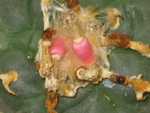|
Description of the Species
As a collector and grower of this fine species
I found myself unsatisfied with the available information and designation
of this species which drove me to researching and
learning much more. This website is a compilation of what I have
found, and have been cross referencing and comparing to my own
plants, personally
grown from seed with location data. With time I hope to expand
on everything you find here along with whatever further new research
that comes available such as some of the newest and best research
done to date by Jaroslav Bohata. For
a quick reference to the description of your favourite variety within
the genus just click the "named" link here below, or continue
scrolling down the page till you find what you are looking for.
Designated Species:
Lophophora Williamsii, Lophophora Diffusa, Lophophora
Diffusa var. Fricii, Lophophora Diffusa
var. Koehresii
A few other somewhat accepted varieties:
Lophophora Diffusa var. Fricii forma albiflora, Lophophora
Williamsii var. Caespitosa,
Lophophora Williamsii var. Jourdaniana, Lophophora
Williamsii var. Decipiens, Lophophora
Williamsii var. Lutea, Lophophora Williamsii
var. Texana
Up until recent years Edward Anderson was at the
forefront of research with this little plant and his studies indicated
that there were two major and distinct populations of peyote representing two
distinct species; that of Lophophora Williamsii and
that of Lophophora Diffusa.
Anderson’s field work suggested that the genus
Lophophora, especially in the north and central regions of its
distribution, were highly variable with regard to vegetative characteristics
such as color, rib number, and size. This variation in numbers
of ribs, color and condition of trichomes (hairs), tended to be
three of the main characteristics that have delineated many past
proposed species. Due to this manner of observation it seems that
Anderson, possibly due to a lack of time was unable to further
clarify his research and simply decided that there was insufficient
evidence to further separate any of the species within the genus.
On the other hand, new peyote research
done by Jaroslav Bohata shows us that we actually have four species
in the genus Lophophora, and possibly more. His findings
indicate that the genus Lophophora is divided into two basic
groups with sufficient differences to classify them separately.
The first group comprises the various forms of the species L.
Williamsii,
which is further subdivided into two infraspecific categories;
those of the northern form and those of a southern form. The
second group also comprises the various forms of the species Lophophora
Diffusa consisting of L.Diffusa, L.Diffusa var.
Fricii, and L.Diffusa var. Koehresii.
Bohata offers the following arguments in support of his
findings:
1) The sections of Lophophora Williamsii and
Diffusa differ chemically in the composition of their alkaloids.
L. Diffusa are a lot closer to each other in this respect and
stand out clearly from that of L. Williamsii. L. Williamsii
contains around 15-30% of the alkaloid mescaline compared with
a maximum concentration of only 1.3% mescaline in L. Diffusa. Along
side of this, L. Williamsii contains 14-17% of the toxic alkaloid
pellotine, whereas L. Diffusa’s content of the alkaloid can be
as high as 65-88%.
2) L. Diffusa inhabits smaller isolated habitats,
and L. Williamsii, on the other hand, occurs over a vast geographical
area.
3) L. Koehresii has been found growing together
with L. Williamsii. Equally, the habitat of L. Fricii is enclosed
within the habitat of L.Williamsii. Despite of this, not a single
instance of hybridization or transitional forms have been observed
wherever they are found living in the same geographical area.
This fact shows that the species are incompatible supporting
the proposed classification. (This one point poses a question
in my mind as to how one could possibly notice whether there
has been a mix or not since L.Williamsii is self pollinating.
What would the person be looking for in a hybrid?)
4) L. Williamsii retains the dried flower remains
for much longer.
5) The species of L. Diffusa also have more
numerous ribs, up to 21 of mostly undulating form, whereas L.
Williamsii produces a maximum of only 13 ribs, which are generally
straight. Anderson’s notes indicate that L.Williamsii grows up
to 14 ribs, but I have yet to find just one plant labelled as
L.Williamsii with any greater number of ribs than 13.
6) The soft tissues of L. Diffusa plants with
their delicate and thin epidermis in shades of green to yellow-green
contrast visibly with the hard and tough, greyish green epidermis
of L. Williamsii.
7) The plants behave differently in cultivation.
Most forms of L. Williamsii are relatively resistant and will
tolerate grower’s occasional cultivation errors, whereas the
species L. Diffusa are much more sensitive to trauma, and prone
to rot.
As a final note, Bohata’s research does assert
that the species L. Diffusa, L. Fricii and L. Koehresii have features
in common and, as a whole, are distinct from L. Williamsii. Here
below are detailed descriptions of the designated species beginning
with the most popular of course, Lophophora Williamsii.
Lophophora Williamsii - Coulter
1894
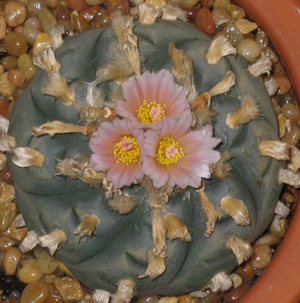 Charles
Lemaire named the species after Sir. C.H. Williams, the British
Ambassador to the state of Bahia. Charles
Lemaire named the species after Sir. C.H. Williams, the British
Ambassador to the state of Bahia.
Lophophora Williamsii in comparison to the other
varieties encompasses an incredibly large area. The Rio Bravo (also
known as the Rio Grande) is the northern boundary along which the
species spreads out as far as Laredo Texas. From this point it
extends along the high plateau land of northern Mexico southwards
until reaching its southern limit in the state of San Luis Potosi,
and Queretaro. To the southwest, the range of L. Williamsii is
limited by a region of volcanic activity, extending along the entire
western edge of the Chihuahua habitat. It is found both in flat
drainless basins and on steep limestone cliff faces, and is better
adapted to life in the sun than any of the other varieties in the
genus.
L. Williamsii is the most potent of all mescaline
containing cacti, containing upwards of 60 different alkaloids,
and is the only species known to be used for hallucinogenic activity
in cultural settings. L.Williamsii has many variations in growth
pattern and flower color most likely due to the extreme range in
altitude and is further divided typically into two different forms
(northern and southern).
Peyote is described as being normally
solitary while at times forming clumps to 1meter wide. The epidermis
is thick and tough, often with a purplish undertone, and bears
a thick layer of cutin and surface waxes. They are globose to
flattened globose, somewhat firm to the touch, blue green or
occasionally reddish-green, 2-6cm high, and 4-11cm in diameter.
The ribs are distinct, straight or spiralled to a maximum number
of 13, and there are horizontal notches formed in the ribs. Field
studies have shown that rib number and variation apparently are
due to localized interactions between genotype and environment.
The wool is sticky, solidifying into tough crests and staying
on the plant for a long time, while the roots have a rough texture.
As mentioned above, there are typically two forms
of Lophophora Williamsii showing themselves to be quite distinct
from each other. They are called, L. Williamsii “southern
type” (with
its centre at Entronque Huizache), and L. Williamsii “northern
type” (centered around Saltillo, Coahuila).
The “southern type” centered around Huizache does
not have a single root, but instead, individual sprouts or buds
will develop their own tuberous roots, becoming quite independent
of the mother plant. This is in sharp contrast to the growth
strategy of the other forms.
In comparison to the so-called northern type, the L.
Williamsii from Huizache is always heterogamous (wikipedia says: "In botany a plant is heterogamous when it carries at least two different types of flowers in regard to their reproductive structures, for example male and female flowers or bisexual and female flowers. Stamens and carpels are not regularly present in each flower or floret. Moreover,
they differ in the structure of the flower, whose style is longer
and the white stigma is much smaller than the northern form resembling
that of L.Diffusa.")
The northern form (from Saltillo, Coahuila),
is extremely resistant to unfavourable conditions of drought,
cold, water, pests and fungi, compared to the other varieties
and is always
autogamous (self pollinating).
The flowers are robust with broad rounded petals of a very pale
pink to white color, and bear a prominent pink midstripe, growing
to between 1 and 2.2cm in diameter. The tube is short, the style
is short and white, and the stigma is fleshy and pink-tinted.
The stamens are white, reaching beyond the stigma, and the anthers
are yellow to orange. Typically the plants flower from March
through September, but as I have learned if the proper conditions
are met the plant will flower all year long. Peyote flowers, in
contrast to those of other cactus genera, have naked ovaries,
or the absence of scales on the ovary wall – a character shared
with the flowers of many other cacti. In Lophophora, all floral
parts are borne on the perianth tube above the ovule-containing
cavity.
One curious and under-reported observation is that
these cacti have thigmotactic anthers.
This means that as its anthers are touched they curl over, depositing
their pollen. This movement can be seen by gently poking the
anthers of an open Lophophora flower. Thus one of the slowest
growing plants in the world makes one of the fastest plant movements.
Pollen of Lophophora is highly variable. Pollen of the Dicotyledonae
tend to have three apertures. Peyote pollen varies greatly in aperture
number, the northern population having 0 to 18 and the southern
population 0 to 6. The grains are spherical, polyporate, with reticular
exine bearing small spicules, and 40 to 53 micrometers in diameter.
The carrying numbers of colpae or apertures produce about twelve
different geometric shapes. Such a variety from a single species
or even population is rare in flowering plants.
The pink cylindrical fruits develop and remain hidden in the
apical wool for about a year (in my personal experience, given
proper conditions fruits will appear in three to four months
from flowering); then elongate rapidly at maturity to protrude
above the woolly centre of the plant. The fruits of Lophophora
are similar to those of Obregonia in that usually only the upper
half contains seeds, whereas Ariocarpus fruits are completely
filled with seeds. These seeds are black and verrocuse (warty),
with a large, flattened, whitish hilum, about 1 mm. in diameter.
Unlike that of L.Diffusa and its varieties, L.Williamsii
has been successfully fertilized by Ariocarpus Fissuratus, L.Diffusa,
Mammillaria Bocasana, M.Zeilmanniana, Strombcactus Disciformis,
Turbinicarpus Pseudomacrochele, Astrophytum Asterias, and Epithelantha
Micromeris.
Synonyms:
Echinocactus williamsii Lemaire ex Salm-Dyck 1845
Anhalonium williamsii Eng., 1854
Echinocactus rapa Fischer et Meyer, 1869
Ariocarpus williamsii (Lem.) Voss., 1872
Anhalonium williamsii (Lem.) Rümpler, 1886
Lophophora lewinii Rusby, 1894
Lophophora williamsii (Lemaire ex Salm-Dyck) J. M. Coulter
1894
Lophophora lewinii (K. Schumann) Rusby 1894
Echinocactus lewinii Hennings, 1895
Mammillaria lewinii Karsten, 1895
Lophophora lewinii Thompson, 1898
Echinocactus williamsii "Hylaeid α" pelotinica Sch. K.,
1898
Echinocactus williamsii "Hylaeid β" v. anhalonica K.
Schumann, 1898
Echinocactus williamsii var. pelotinica Rouh., 1927
Echinocactus williamsii var. anhalonica Rouh., 1927
Lophophora caespitosa Krzgr., 1935
Lophophora texana Fric ex Roeder, 1935
Lophophora williamsii var. decipiens Croizat, 1944
Lophophora williamsii var. pentagona Croizat, 1944
Lophophora williamsii var. pluricostata Croizat, 1944
Lophophora echinata Croizat 1944
Lophophora williamsii var. texana Krzgr., 1961
Lophophora lutea var. texana (Fric ex Krzgr.) Backbg., 1961
Lophophora fricii Habermann 1974,
Lophophora jourdaniana Habermann 1975
L. williamsii var. fricii (Habermann) Grym 1997,
L. diffusa subsp. fricii (Habermann) Halda 1997
Lophophora Diffusa – Croizat
1944
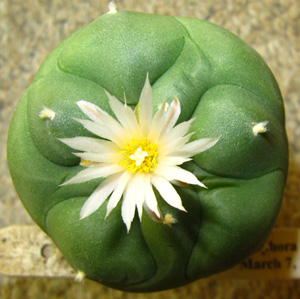 This
species is the most southern population of the genus and plants
grow only in a small area along the basin of the Rio Extorax, between
the settlements of Vizarron, Toliman Ninas Las Palmas, Rio Blanco
and Bucareli, in the state of Queretaro. This
species is the most southern population of the genus and plants
grow only in a small area along the basin of the Rio Extorax, between
the settlements of Vizarron, Toliman Ninas Las Palmas, Rio Blanco
and Bucareli, in the state of Queretaro.
L.Diffusa was first discovered by Dr. J. N. Rose
in 1905, but the first to realize it was
a new species was A.V. Fric, who described it as Ahalonium sp. Fl. Luteo Fric.
This species differs from L. Williamsii in that it
is yellowish green rather than bluish green in color, having diffused
ribs, not clearly defined, up to 21 in numbers. The podaria or
tubercles are rarely elevated, but are broad and flat as a much
softer and succulent plant, with a thin, delicate epidermis, easily
bruised, and a longer flower tube,
and the tissues contain little to no mescaline but mainly pellotine
instead. The structure and shape of the roots are similar to the
smooth and fine epidermis.
The flower color of Lophophora varies from
deep reddish-pink to nearly pure white; those of L.Diffusa rarely
exhibit any red pigmentation, making them usually appear white or
sometimes a light yellow because of the reflection of yellow
pollen from the centre of the flower. This yellow reflection
has led some to name the species L. Lutea which is a misrepresentation
according to the most recent studies.
The pollen of L.Diffusa has less variation than that of
L.Williamsii, and it also has a much higher percentage
of grains that are of the basic tricolpate (three-aperturate)
type. Thus the basic dicotyledon pattern is best observed in
the southern population, whereas more complex grains occur in
the northern localities. Small tricolpate grains probably are
more typical of the ancestors of the cacti, and the more elaborate
geometric designs of L.Williamsii seem to represent greater evolutionary
divergence and specialization.
The stem of L.Diffusa often grows up to15 cm. in diameter, and
the fact that they grow on slate, does not allow the plants to
contract and hide underground when it gets to hot. During drought,
L. Diffusa will rely on the size of its stem, which explains why
it also grows in clusters.
None of the Diffusa family directed species
are autogamous. All species in the Diffusa family,
unlike L.Williamsii are self-sterile (heterogamous)), and unable
to receive pollen from L.Williamsii for fertilization, and apparently
only able to mix with their own kind. Over the next
couple of years I will be experimenting to see if the plant can
mix with any of its other varieties or not.
Lophophora Diffusa var.
Koehresii – Riha
1996
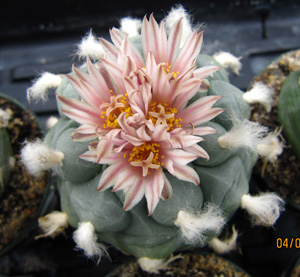 This species is found immediately south of L.Williamsii and north
of L.Diffusa, at the lagoon of Rio Verde, San Francisco, from Las
Tablas to Las Palomas in the state of San Luis Potosi, Mexico.
The distribution is mainly restricted to areas with alluvial soil.
It was discovered by Gerhard Kohres a grower of cacti-seeds in
Germany along with Professor Schreirer in 1975, and is said to
be the smallest species of the Lophophora genus. Most interesting
is the fact that the habitats of L. Williamsii and L. Koehresii
meet and even overlap at San Rafael, but in all observations to
date, no hybridization has been noted. This species is found immediately south of L.Williamsii and north
of L.Diffusa, at the lagoon of Rio Verde, San Francisco, from Las
Tablas to Las Palomas in the state of San Luis Potosi, Mexico.
The distribution is mainly restricted to areas with alluvial soil.
It was discovered by Gerhard Kohres a grower of cacti-seeds in
Germany along with Professor Schreirer in 1975, and is said to
be the smallest species of the Lophophora genus. Most interesting
is the fact that the habitats of L. Williamsii and L. Koehresii
meet and even overlap at San Rafael, but in all observations to
date, no hybridization has been noted.
L.Diffusa var. Koehresii is considered a dwarfed,
depressed spherical, solitary species with a market dark green
epidermis that does not sprout spontaneously in the wild. The initially
distinct ribs break down in later years, sometimes almost disappearing
and transforming into low podaria. The flowers are pink to cream
supplemented with a prominent brown midstripe, more visible on
the outside than on the inside, having unusually thin petals which
are relatively large, up to 4.5 cm. The stigma is white
or rosy pink in exceptional cases, and sometimes maintains a yellowish
or greenish undertone.
The plant sprouts unusual small spherical
fruits with the remnants of the perianth shed before ripening.
The number of seeds are usually under 20 and are the
largest of all Lophophora with a very characteristic
testa.
Higher ratios of pellotine to mescaline give support for this
species inclusion with L.Diffusa. Like L. Diffusa, L. Koehresii
is also self-sterile and requires cross pollination to produce
seed.
Bohata justifies his raising this taxon to the level of species
because it inhabits an area separate and distinct from that of
L. Diffusa, it differs from L. Diffusa in its ecological preferences,
and has distinct morphological features, such as fruit shape, body
color, and seed testa. In comparison to the others, it is also
considerably smaller (rarely exceeding 10 cm. in diameter), and
lives exclusively at the bottom of flat valleys or basins rooted
in soft alluvial sediments. In fact, it is so specialized in this
respect that it works for its protection by retracting into little
holes in which it hides from the scorching heat during the dry
periods.
There has been no offsetting observed among L. Koehresii in the
wild. Adult plants typically grow to between 6 and 10 cm in diameter,
while have 13 to 21 ribs that break down into separate podaria
in some specimens so that the ribs are no longer discernable.
As a seedling, the plant invests most of its time developing its
underground parts. The taproot is always wider in plants of two
to six years of age than the above ground portion. This proportion
of root to stem size is the greatest in all the species of Lophophora.
Lophophora Diffusa var. Fricii - Habermann1974
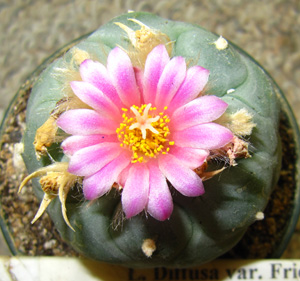 This
species was named to honour one of the greatest Czech
cactus growers Alberta Vojtech Fric, who was the first
to collect the plants in Mexico in 1923 and bring
them to Europe as a new species. A live plant of Lophophora Fricii
was discovered by Alberto Vojtech Fric during his only journey
to Mexico in 1923. He named it Anhalonium sp. fl. Rosea
Fric. The specimen was taken from limestone rock formations
near San Pedro in central Coahuila. Habermann later described Lophophora
Fricii in the journal Kaktusy in 1974. This
species was named to honour one of the greatest Czech
cactus growers Alberta Vojtech Fric, who was the first
to collect the plants in Mexico in 1923 and bring
them to Europe as a new species. A live plant of Lophophora Fricii
was discovered by Alberto Vojtech Fric during his only journey
to Mexico in 1923. He named it Anhalonium sp. fl. Rosea
Fric. The specimen was taken from limestone rock formations
near San Pedro in central Coahuila. Habermann later described Lophophora
Fricii in the journal Kaktusy in 1974.
The habitat of L. Fricii is a relatively small area found in the
mountains surrounding the Viesca Basin in south-western state of
Coahuila. Four locations of L. Fricii are presently known. Two
are located south of Viesca in the mountainous massif of the Sierra
El Marmol. One location is north of Viesca in the sierra Zavaleta,
and one is east of Viesca at the foot of the Sierra de Parras.
The last known form, growing near El Amparo, is found in the plains
at the foot of the hills and also higher up the hillsides as well.
In the Sierra Zaveleta, the plants take advantage of the favourable
micro-climate of ravines and dry watercourses, coming down to the
very bottom of the hills. Although the habitats of L.Fricii and
L.Williamsii mix in this area, nobody has ever found evidence of
the two species merging in the wild.
L.Fricii has been found to colonize rock crevices,
and make clusters of several dozen reaching widths of up to 40
cm. and heights of 15 cm, but solitary plants are also present.
The epidermis of the plant is of a grayish green color. Solitary
plants are rare, but the largest plant found was fully 15 cm. in
diameter. Like L.Diffusa it also withstands drought by producing
larger stems rather than retracting underground. Typically, the
habitats of L. Fricii are composed of limestone subsoil and stiff
clayey substrates.
L. Fricii is described as a flattened spherical species of solitary
to normally clustering growth forms, having a gray-green epidermis.
The numerous ribs (up to 21) are inconspicuous similar to L.Diffusa.
The flowers vary from nearly white to carmine-red
flowers (naturally
occurring populations do not always bear carmine red flowers, but
often are pale pink like L.Williamsii and commonly a dark shade
of pink). The seeds are similar to those of L. Williamsii at first
sight, but differ in the shape of the hilum, and texture of the
testa. The size of the stem will
be as large as 15 cm. in older plants.
As a final note, L.Fricii and L.Diffusa bear similar concentrations
of mescaline to pellotine even though they are separated by about
400 miles.
Lophophora Diffusa var. Fricii
forma albiflora
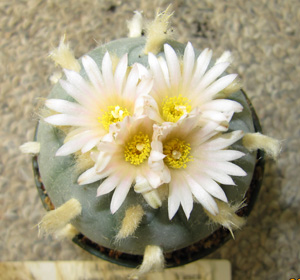 This white flowering variety of L. Fricii is known for having a
peculiar yellowish epidermis, and can be found southwest of Viesca
growing more or less solitary and running up open slopes. This white flowering variety of L. Fricii is known for having a
peculiar yellowish epidermis, and can be found southwest of Viesca
growing more or less solitary and running up open slopes.
Lophophora Williamsii var.
Caespitosa -
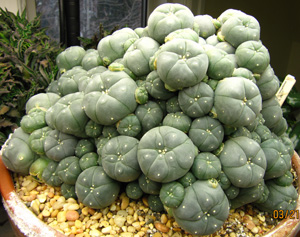 The
appearance of Lophophora Williamsii varies widely, and in some
cases the plants occur as single headed individuals, while in
others they become caespitose, forming dense clumps up to two
meters across with hundreds of heads. Plants in Texas and other
areas do not seem to form large clumps as often as those in the
state of San Luis Potosi, but plants with several pups can arise
as the result of harvesting heads for medicinal use, injury by
grazing animals or other factors. The
appearance of Lophophora Williamsii varies widely, and in some
cases the plants occur as single headed individuals, while in
others they become caespitose, forming dense clumps up to two
meters across with hundreds of heads. Plants in Texas and other
areas do not seem to form large clumps as often as those in the
state of San Luis Potosi, but plants with several pups can arise
as the result of harvesting heads for medicinal use, injury by
grazing animals or other factors.
Some say that nothing found about this plant indicates
it to be a regularly occurring variation with its own distinct
population. Due to this it is still considered to be a simple cultivar
of plants having a higher propensity to tiller readily, and simply
considered a hybrid cultivar. In all fairness though, there has
been a newly discovered location near La Perdida (which is the
location provided in collection data for seeds I have ordered and
planted) in the state of Tamaulipas, Mexico that contains plants
similar to this cultivar.
 The caespitose or several-headed condition of the
peyote cactus apparently occurs through the activation of advantageous
buds that appear on the tuberous part of the root-stem axis below
the crown. These buds can be easily scene on seedlings I have grown
from the location provided above and is depicted here to the left.
Note! The seedlings are five months old and about 1 cm in diameter
but shooting buds none the less. The caespitose or several-headed condition of the
peyote cactus apparently occurs through the activation of advantageous
buds that appear on the tuberous part of the root-stem axis below
the crown. These buds can be easily scene on seedlings I have grown
from the location provided above and is depicted here to the left.
Note! The seedlings are five months old and about 1 cm in diameter
but shooting buds none the less.
Some people might think that there shouldn’t be
a separate classification for this variety since many of the Lophophora
forms will develop pups over the years. I have included it here
because over the year I have planted around four thousand Lophophora
seeds of most known varieties, and I have not scene a single seedling
tiller (although I have seen three to four year old plants grow
pups). Yet ever since I have ordered seeds of the caespitose variety
from La Perdida all such seedlings have immediately began growing
clusters within weeks of showing themselves. Is that enough to
consider it a distinct species? Only the credited botanists are
really qualified to say is what I am told.
Mescaline to Pellotine concentrations for Caespitosa
varieties are similar and consistent to those of L.Williamsii.
Lophophora Williamsii var.
Jourdaniana – Habermann
1975
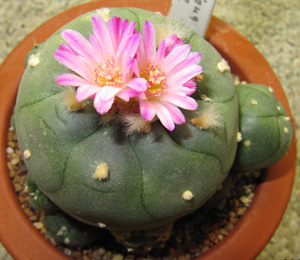 Originally described as having violet
red flowers, and an inability
to be fertilized by L.Diffusa, L.Fricii or L.Williamsii and its
varieties. The plant has apparently been crossed successfully by
a Russian botanist by the name of Serge Batov,
but not successfully done by anyone else. Originally described as having violet
red flowers, and an inability
to be fertilized by L.Diffusa, L.Fricii or L.Williamsii and its
varieties. The plant has apparently been crossed successfully by
a Russian botanist by the name of Serge Batov,
but not successfully done by anyone else.
No occurrence of this variety is known in nature,
and no features, including chemical analysis support Lophophora
Jourdaniana being anything other than an odd variant of L.Williamsii,
or possibly a cultivation hybrid. Some people propose that L. Jourdaniana
may perhaps be a hybrid between Lophophora Williamsii and Lophophora
Diffusa var. Fricii.
The flowers of Lophophora Jourdaniana are
frequently cleistogame (small,
unopened and self pollinating). Apparently it is not possible to
fertilize L. Jourdaniana with the pollen of L. Williamsii, nor
with the pollen of L. Diffusa or L. Fricii, which is something
I will be experimenting with over the next couple of years.
Some sources suggest that this species contains
some mescaline, but at a much lower concentration than L. Williamsii,
while others say it doesn't contain the alkaloid at all,
because this plant is more related to the
Diffusa family
than Williamsii. There are two ways of finding out, but
I think the best would be proper DNA testing. Let's hope someone
of authority is on that.
Lophophora Williamsii var.
Decipiens – Croizat
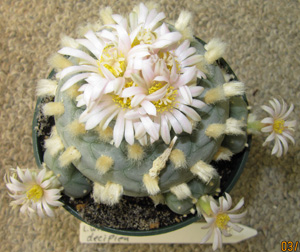 Originally
described by Leon Croizat. L. Decipiens can be found near Torreon,
and El Ampero, in the state of Coahuila Mexico on the top of
surrounding high rocky peaks, although there hasn't ever been
found any at such a location since the mentioning of this location. Originally
described by Leon Croizat. L. Decipiens can be found near Torreon,
and El Ampero, in the state of Coahuila Mexico on the top of
surrounding high rocky peaks, although there hasn't ever been
found any at such a location since the mentioning of this location.
Said to be quite distinct from L.Williamsii by
having a pronounceable ashy grey color and lacking noticeable rib
formations. Instead, it has diamond shaped conical tubercles that
are spiral in form similar to Strombocactus Disciformis, but with
flowers the same as L.Williamsii.
Mescaline and Pellotine concentrations are similar to that of L.Williamsii.
Lophophora Wiliamsii var.
Lutea-
This variation is said to bear distinctly yellow flowers, a yellowish
down of trichomes, and to have tubercles unlike that of L.Williamsii.
Anderson indicates that there is no independent growth population
of this form and that the flower colorations are found sporadically
in normal populations of L.Williamsii with the yellow tone simply
being a reflection of pollen on brightly lit days.
Note!! This is the one variety of Lophophora that I have not been
able to locate seeds for planting. I have also found notes that
this species has simply been misidentified and is nothing more
than L.Diffusa glistening in the sun.
Lophophora Williamsii
var. Texana –
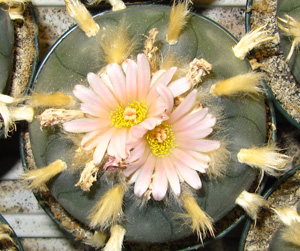 This variation also termed L.Williamsii var. Texensis, is most
often found growing solitary in the regions of the Rio Grande
in southern Texas, and there is no extra special information
available different from that of L.Williamsii. This variation also termed L.Williamsii var. Texensis, is most
often found growing solitary in the regions of the Rio Grande
in southern Texas, and there is no extra special information
available different from that of L.Williamsii.
email: dr_frank @ magicactus.com
Mailing
address:
Frank
Valente
MagiCactus.com
56 Dewhurst Blvd.
Toronto, Ontario
M4J 3J3
© 2008, Frank Valente |
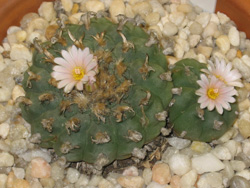
 Charles
Lemaire named the species after Sir. C.H. Williams, the British
Ambassador to the state of Bahia.
Charles
Lemaire named the species after Sir. C.H. Williams, the British
Ambassador to the state of Bahia.